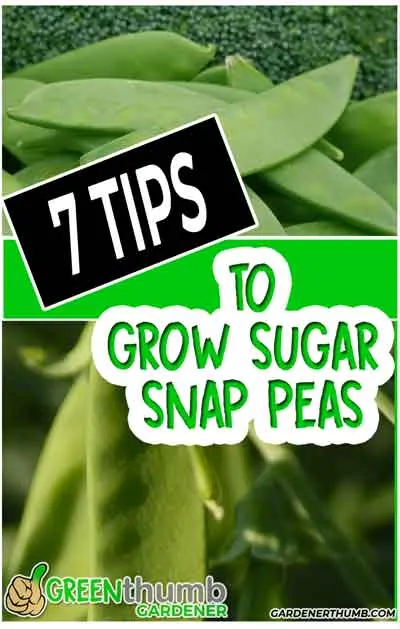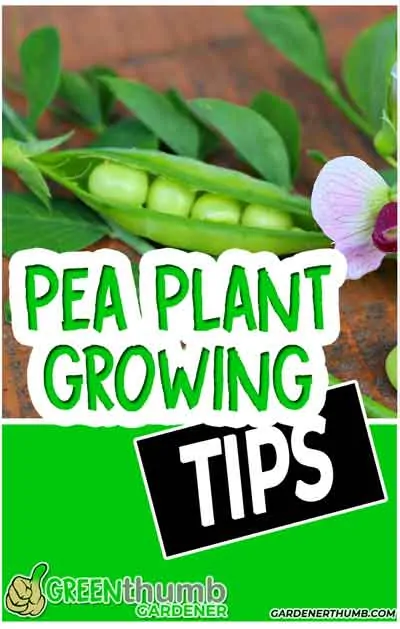Growing Sugar Snap Peas | 7 Tips for Healthy Plants
Last Updated: 10/30/21
What is healthy and sweet that can be added to stir fry or into your salads? You guessed it – Sugar Snap Peas. Growing sugar snap peas is a breeze when you direct sow seeds in your garden at the right time of the year.
Sugar snaps are a much like snow peas & garden ones. Sugar snap peas are a cross between snow peas and garden peas.
Green thumb Gardener occasionally links to product and/or services offered by vendors to assist you with all your gardening needs. Some of these may be affiliate links, meaning we earn a small commission if items are purchased.
Want to Download a Garden Hack Guide for FREE

Enter your email below and we will send you a guide to help you SAVE money in your garden.
What is the best way to grow sugar snap peas in your garden? We prefer to grow peas by directly sowing the pea seeds in the garden soil.
You can easily grow peas from seeds. Follow these simple tips below to help you plant sugar snap peas like a garden boss:
- Start your seeds of sugar snap peas in the ground for healthiest plants
- Planting peas around when the temperature is just right for the seeds to sprout quickly
- Feed peas with the right nutrients
- Plant peas in an area with adequate sunlight
- Watering best practices for growing your snap peas
- Get your soil mixture and pH just right for your peas
- Know when to pick & harvest peas
1- Start Your Sugar Snap Peas in The Ground For Healthiest Plants
Start your seeds of sugar snaps in the ground or its final destination. Growing peas like this will help to produce a healthier plant.
This tip applies to any sweet peas & most vegetables. It’s always smart to start planting from seed if at all possible.
Snap Peas can readily acclimate a lot easier to those growing conditions when it’s growing in the soil and its roots remain untouched.
Most peas that you get from a greenhouse or nursery are given ideal conditions with ideal temperatures and ideal soil.
The pea plant are given a lot of fertilizer and they’re growing nice and tall for you.
You throw them in the ground here and the peas might be a little bit less than ideal.
You get something called transplant shock and that is a gardener’s worst nightmare because it affects the time till maturity for your peas.

We will try to keep all these things in mind with these tips to help grow peas.
When it comes to pea plants, there is nothing more crucial than the time to maturity simply because peas are one of those fringe plants that you need to get the timing right between spring and summer.
Of course, we still recommend planting peas in containers for this to also help get this timing down.
Usually you plant peas about 2 inches apart at a depth of about 1 inch to 2 inches deep. 1 inch deep is what I do for my Fall crops since the soil is warmer.
You can space peas more than 2 inches apart if you want, but I wouldn’t suggest to put seeds any closer in your garden.
2- Planting the Snap Peas Seeds
Sugar snap peas – it’s not really an early spring vegetable and it’s not really a summer vegetable. It is sorta in “The Space Between” as the Dave Matthews Band sang about. It is that gray area where planting peas the right date is important to keep in mind.
The ideal temperature to grow peas in your garden is not when there is frost all day because they won’t grow very fast. The temperature to grow sugar snap peas can’t be too hot otherwise you’ll notice that they start to burn.
Geez, growing snap peas sounds like the story of Goldilocks and the Three Bears to get it just right.
That perfect timing is during the transition from early spring till summer, which is usually around St Patrick’s Days (March 17) in most parts of the northern hemisphere.
You want to make sure that the night temperatures are averaging above freezing and around 80 degrees.
You may also plant in the Fall. Start with a planting of peas in late summer to early Fall to pick before last frost date.
Check out the post below to get more information about growing peas & gardening tips.
3- Feed the Sugar Snap Peas with the right nutrients
Fertilizing your pods is definitely a step that some people might skip. Peas are one of those vegetables that do produce its own nitrogen.
Most people think “Its nitrogen-fixing, so you don’t need any fertilizer. It’s going to fix its own nitrogen and grow very well.” Unfortunately, this sentiment is not ideal.
All nitrogen-fixing plants, whether or not it’s a bush bean, a pole bean or sugar snap pea plant or any of your legume family plants needs to be fertilized.
Fertilizing is so important because the difference that you will have in your harvest in your plant’s health and just the plant size is so incomparable.
We always give our snap peas a nitrogen-rich fertilizer. You can give them a one to one ratio of fish emulsion and blood meal. You want to add this directly in the planting hole, so when the seeds sprout, they’re literally growing in that.
You can give the pea seeds an additional boost of nitrogen once they start flowering. The flowering will happen naturally. Growing sugar snap peas is not like tomatoes where you stress the plant with phosphorous to grow it to flower.
The added nitrogen encourages the pea plant to grow taller and greener all along the stem. Once the sugar snap pea plant reaches a certain height and a certain age, it’s going to set flowers regardless of how much phosphorus you have or not and that’s the miracle behind peas.
4- Place Your Peas In Adequate Sunlight
Another crucial and important factor along with the temperature is sunlight. You may have very sporadic temperatures early in the spring and that is obviously due to the sun.
You don’t want the sugar snap peas plants in the hot gleaming sun all day long because they will fry and believe it or not, peas don’t need that much sun.
You can grow them in about 5 to 6 hours of full sun. Sugar snap peas will even do well in as little as 4-5 hours.
You don’t need to put peas in full sun. Don’t give them eight hours, don’t give him 10 hours.
Too much sunlight will cause the bottoms to start turning yellow and brown. At this point, hey can’t uptake water and it’s going to kill the top soft slowly.
The tops always seem to be a shade of green and the bottom always seems to be yellow. Put them in a spot with 5-6 hours of sunlight.
5- Watering Best Practices for Growing Sugar Snap Peas
These little green plants need a moderate amount of water throughout their growing cycle.
The reason being is because the plant has a very thin stem.
It’s not like a plant whereas the plant grows, the stem grows as well to adjust for the amount of water uptake.
The stem will always be the same diameter, so you have to give it lots of water.
The plant will literally kill itself off from the bottom if there is not enough water.
You do want to make sure that your soil does drain well though.

6- Ideal Soil For Growing Sugar Snap Peas
Getting your soil and the pH correct is vital to growing a healthy batch of sugar snap peas.
Middle of the road pH levels are best for snap peas, so 7.0 neutral levels are best. Don’t go too acidic or too alkaline.
You can measure the pH levels by having your soil tested each year. We recommend to do it when you first start a garden and maybe every 2-3 years after that.
In a pinch, you can use something like this found here.
Generally, though adding a good amount of compost each year before planting will usually level the playing field and buffer the soil pH.
Having a loose, well-draining soil is so vital for growing sugar snap peas because these plants have a very small stem. The peas need every ounce of root penetration. This helps with water absorption for the peas root system.
You may need to amend your soil if you have hard compact soil. Your pea plant may only grow a foot and will never fruit.
Give them a healthy dose of compost, maybe pure compost worm castings and sand.
This step ensures that the roots are going to go straight down.
One way you can tell that if your soil is loose enough is if you can take your finger and barely push and work your way down in the soil. You should be able to take your hand and work it right down in the soil and dig about three or four inches before you hit anything at all.
That’s a good way to make sure your soil is loose enough for your peas.
7- When to Harvest Your Snap Peas
You made it through the fringe period of the spring season and they flowered and developed into pods. What’s next? You want to pick these little green pea pods at the peak time for the best flavor.
Typically, most varieties of sugar snap peas will be ready to harvest & pick between 50 and 70 days. Obviously, this depends on the amount of sunlight, water, and nutrients (make sure you read above again) that each pea plant gets.
We prefer to pick peas pretty immature, so don’t wait until the peas are really rounded and full.
You can vary your time to pick peas to suit your taste. In fact, start picking when you first notice them bulging and see what tastes best for you.
Check out this video about growing sugar snap peas on a trellis:

Further Reading
More Info
Growing sugar snap peas is not very difficult at all. They are pretty easy to grow once you grow them a few times and are accustomed to variable weather conditions during this fringe period.
Sometimes you have colder spring, sometimes you have hot, warmer springs.
The temperature variances are always changing year by year. You will find using the tips above will pretty much guarantee you will grow peas. Hopefully, you will play in the dirt while growing your sugar snap peas.
Check out our mega insider secret gardening tips guide to growing snow peas, garden peas, and everything in between here.
Let me know in the comments below what types of peas you are growing or any other questions you want to be answered.








